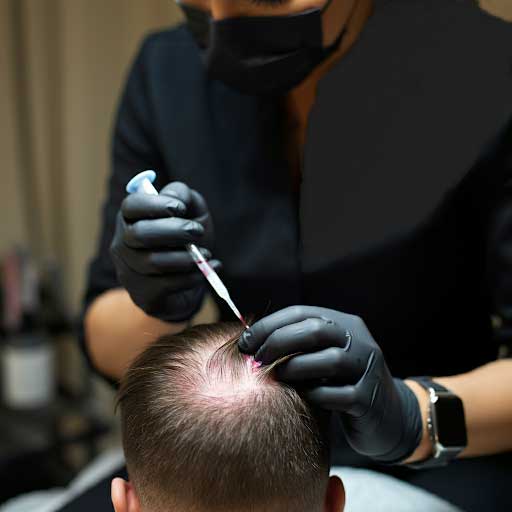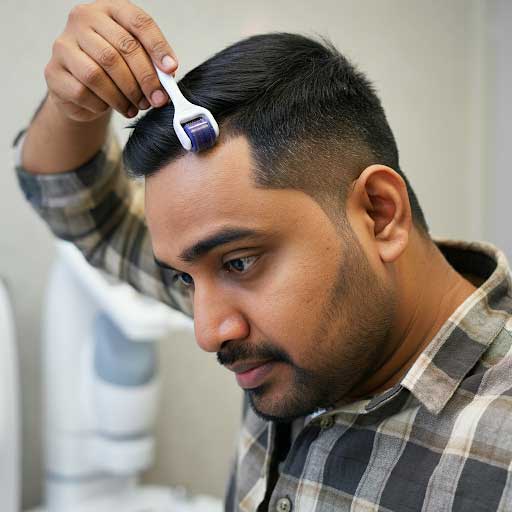
Stem Cell Therapy
Stem cell therapy regenerates hair follicles by injecting stem cells into the scalp, promoting hair growth and reducing thinning.
How It Works
Stem cells are extracted from fat tissue or bone marrow. Processed cells are injected into areas of hair loss. Often combined with microneedling or PRP for better results.
Cost
$3,000–$10,000, per session, not covered by insurance.
Results vary widely and may not be permanent without mainteexte.
Timeline
Most patients require 1–3 sessions, spaced 4–6 weeks apart, depending on the severity of hair loss and individual response. Initial improvements in hair thickness and density may appear within 3–6 months after treatment.
Who Benefits
Promising but variable; best for early-stage hair loss and early-stage hair loss may require fewer sessions than extnced baldness. Healthier individuals tend to respond better.
Efficacy
Hair Density Increase: Studies report a 29–40% improvement in hair density within 6 months of treatment.
Hair Thickness Growth: Patients see a 20–30% increase in hair shaft thickness after 3–6 months.
Response Rate: Approximately 70–80% of patients experience noticeable improvements in early-stage hair lossext>
Safety
Minimally Invasive: Uses your own cells, reducing the risk of rejection or allergic reactions.
Mild Side Effects: Possible redness, swelling, or tenderness at injection sites.
Experimental: Long-term safety and FDA approval for hair loss applications are still pending.

Low-Level Laser Therapy (LLLT)
LLLT uses red or near-infrared light to stimulate hair follicles, boost blood flow, and prolong hair growth phases. It’s effective for mild to moderate androgenetic alopecia.
How It Works
Stimulates growth by activating hair follicle mitochondria to produce more ATP.
Reduces inflammation and soothes scalp conditions linked to thinning.
Improves Circulation by enhancing nutrient and oxygen supply to follicles.
Cost
Home devices cost $200–$3,000 depending on features.
In-clinic sessions cost $50–$150 per session; packages often available.
Treatment Options
Laser combs, helmets, or caps (brands like Capillus or iRestore).
In-clinic professional-grade systems.
Timeline
3–4 sessions weekly for 15–30 minutes.
Visible in 4–6 months; optimal at 9–12 months.
Who Benefits
Ideal for early-stage hair loss, androgenetic alopecia, or stress-related thinning. Not effective for complete follicle inactivity.
Efficacy
Hair Density Improvement: Clinical studies report a 19–37% increase in hair density after 16–26 weeks of use.
Hair Thickness Growth: Patients see a 20–30% increase in hair shaft thickness after 3–6 months.
Effective for Both Genders: Proven to work for androgenetic alopecia in men and women.
Response Rate: About 80–90% of users see stabilization of hair loss, and 60–70% notice regrowth.
Safety
Non-Invasive: Painless and safe with no downtime.
Mild Side Effects: Some users report temporary scalp redness or irritation.
FDA-Cleared: Devices like laser caps and combs are approved for home use.
How to Buy
To purchase an FDA cleared iRestore low-level laser therapy helmet (for men and women), click here: https://amzn.to/4hkYYJQ

Platelet-Rice Plasma (PRP) Therapy
PRP uses concentrated platelets from your blood to rejuvenate follicles, improving hair density.
How It Works
Blood draw, centrifugation to isolate platelets, and scalp injections.
Growth factors in PRP activate follicles.
Cost
$500–$2,000, per session, based on clinic and location.
Typically required every 4–6 months.
Timeline
Initial Course: 3 sessions, spaced 4–6 weeks apart.
Visible in 4–6 months; optimal at 9–12 months.
Who Benefits
Best for early-stage androgenetic alopecia. Not suitable for advanced baldness or certain medical conditions.
Efficacy
Hair Count Increase: Studies report a 30–40% increase in hair density within 3–6 months of treatment.
Thickness Growth: Hair shaft diameter improves by 20–30% after 3–4 sessions.
Response Rate: About 70–85% of patients experience noticeable hair regrowth, particularly in early-stage hair loss.
Safety
Minimally Invasive: Uses your own blood, reducing allergy risks.
Mild Side Effects: Redness, swelling, or temporary soreness at injection sites.
FDA-Compliant: PRP is widely used for hair loss but not specifically FDA-approved for this indication.

Microneedling
Microneedling creates micro-injuries on the scalp to boost hair growth through natural healing.
How It Works
Releases growth factors to regenerate follicles.
Improves collagen, blood flow, and topical treatment absorption.
Cost
At-home microneedling devices, like dermarollers, are significantly less expensive, costing around $20–$100, but results are less effective compared to professional treatments due to shorter needle lengths and reduced stimulation. While at-home tools can enhance topical medication absorption, they lack the potency of dermatologist-administered procedures.
Professional microneedling treatments for hair loss typically range from $200 to $700 per session, depending on location, provider expertise, and session length. Patients often require 4–6 sessions for noticeable results, bringing total costs to $800–$4,200 for a treatment course. Maintenance treatments might also be necessary, adding to the long-term expense.
Timeline
Use the dermaroller 2–3 times per week (needle length of 0.25mm - 0.5mm) or once a week/10–14 days (needle length of 0.75mm - 1.0mm) to allow adequate healing time between sessions.
Who Benefits
Best for early-stage androgenetic alopecia. Not suitable for advanced baldness or certain medical conditions.
Efficacy
Hair Density Increase: Studies show a 20–40% improvement in hair density over 3–6 months.
Boosts Effectiveness: Enhances absorption of topical treatments like minoxidil, increasing their efficacy by up to 50%.
Response Rate: About 60–75% of users report noticeable regrowth, especially for androgenetic alopecia.
Safety
Minimally Invasive: Safe for most skin types with minimal downtime.
Mild Side Effects: Temporary redness, irritation, or slight bleeding.
Precautions: Not recommended for those with active scalp infections or certain skin conditions.

Exosome Therapy
Exosome therapy is a treatment for androgenetic alopecia and hair thinning through the use of extracellular vesicles derived from mesenchymal stem cells.
How It Works
Scalp is numbed and injected with exosomes in under an hour.
Promotes hair follicle regeneration and growth.
Reduces inflammation and Enhancing scalp health.
Cost
A single session ranges from $3,500 to $6,000, depending on the clinic, the number of exosomes used, and location. Most patients require 1–2 sessions for significant results, spaced 3–6 months apart.
Exosome therapy tends to be more expensive than alternatives like PRP (Platelet-Rich Plasma) because of its advanced biotechnology and research requirements.
Timeline
Exosome therapy typically shows initial results within 3–6 months after treatment.
Significant improvements in hair density and follicle health appearing after 6–12 months.
Who Benefits
Suitable for various types of hair loss, including androgenetic alopecia.
Efficacy
Studies suggest a 30–40% increase in hair density within 6 months, but more research is needed for conclusive data.
Some cases report improvements of up to 50–60% in localized areas, depending on the severity and type of hair loss.
Safety
Minimally invasive with low risk of side effects.
Possible mild redness, swelling, or tenderness at the injection site.
Long-term safety still under study due to the therapy’s novelty.

Corticosteroids
Corticosteroids are a treatment for alopecia areata, an autoimmune condition where the immune system targets hair follicles causing round or oval bald patches on the scalp, face, or body. Corticosteroids reduce inflammation and suppress this attack.
How It Works
Corticosteroids can be administered by injection, topically, or orally to treat alopecia areata.
By calming the immune response, corticosteroids create an environment where hair can grow back, especially in mild or early-stage cases.
Cost
Corticosteroid injections price per session: $50–$300+ without insurance, depending on the clinic and number of injections. Often covered for medical necessity, reducing out-of-pocket expenses.
Topical corticosteroids price range: $20–$100+ per tube/bottle, depending on the brand and potency. Often covered, but copays vary. Generic options are usually more affordable.
Oral corticosteroids cost: $10–$50+ for a course, depending on the medication and pharmacy. Often covered by insurance, though long-term use is rare due to side effects.
Timeline
Results may begin in 4–6 weeks with consistent treatment.
Optimal regrowth often takes 3–6 months.
Who Benefits
Encourages hair regrowth in mild-to-moderate cases.
Efficacy
Less effective in extensive or long-term alopecia areata.
Corticosteroid injections are effective in 60–75% of cases for localized patches, especially when started early.
Approximately 25–50% of patients using topical corticosteroids see significant regrowth in localized alopecia areata, but the response is often slower and less consistent.
Safety
Injections: Minimal side effects when localized.
Topical: Low risk, but prolonged use can thin skin.
Oral: Higher risk of systemic effects like weight gain or mood swings; used for severe cases.